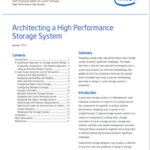Designing a large-scale, high-performance data storage system presents significant challenges. This paper describes a step-by-step approach to designing such a system and presents an iterative methodology that applies at both the component level and the system level. A detailed case study using the methodology described to design a Lustre storage system is presented.
Lustre and Persistent Storage
Lustre was originally developed as the fastest scratch file system for HPC workloads that supercomputer centers could get, but has over the years matured to be an enterprise-class parallel file system supporting mission-critical workloads. Unfortunately, in spite of Lustre having become extremely attractive to enterprises and adopted by IT departments, some naysayers continue toclaim that Lustre is still just a scratch file system. We in the Lustre community see quite a different picture.
Enterprise HPC Storage System
In many HPC environments, the storage system is an afterthought. While the main focus is on the CPU’s the selection and implementation of the storage hardware and software is critical to an efficient and productive overall HPC environment. Without the ability to move data quickly into and out of the CPU system, the HPC users would not be able to obtain the performance that is expected.






